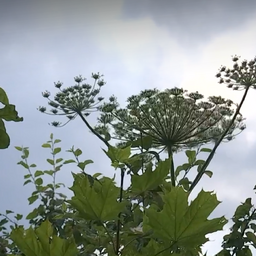Mürgise karuputke kolooniaid võib leida mitmetest kohtadest, ka linnades. Näiteks
Laagri rauteejaama juures
kasvab karuputk juba paar aastat. Kuigi seda on suvel
korra raiutud
, kasvab see uuesti. Andžela, kahe lapse ema, ei mõista, miks karuputk sellises kohas kasvada lastakse.
Laagri rauteejaama juures
Tõlge fraasile: Laagri rauteejaama juures
EN
near Laagri railway station
korra raiutud
Tõlge fraasile: korra raiutud
EN
cut down once
Keskkonnaamet teatas veebruaris, et lõpetab karuputke tõrjumise ja alates 2028. aastast on see
maaomanike ülesanne
. Ameti juhi Rainer Vakra sõnul oli amet sunnitud
tegema kärpeid
, kuid nüüd on raha leitud.
maaomanike ülesanne
Tõlge fraasile: maaomanike ülesanne
EN
the responsibility of landowners
tegema kärpeid
Tõlge fraasile: tegema kärpeid
EN
making cuts
Varem taheti maaomanikele panna
karuputke hävitamise kohustus
, kuid nüüd on sellest loobutud. Siiski peavad maaomanikud ise putke tõrjuma, sest iga aasta leitakse uusi kasvukohti.
karuputke hävitamise kohustus
Tõlge fraasile: karuputke hävitamise kohustus
EN
the obligation to destroy giant hogweed
Jõelähtme vallavanem Andrus Umboja ei pea seda õigeks. Ta arvab, et
tsentraalse korralduse kaotus
võib
viia kaosesse
.
tsentraalse korralduse kaotus
Tõlge fraasile: tsentraalse korralduse kaotus
EN
loss of central management
viia kaosesse
Tõlge fraasile: viia kaosesse
EN
lead to chaos
Eestis on viimase 15 aastaga
saadud karuputkest lahti
800 hektaril, kuid 2400 hektaril
kasvab ta edasi
.
saadud karuputkest lahti
Tõlge fraasile: saadud karuputkest lahti
EN
got rid of giant hogweed
kasvab ta edasi
Tõlge fraasile: kasvab ta edasi
EN
it continues to grow
Colonies of toxic giant hogweed can be found in various places, including cities. For example, near Laagri train station, hogweed has been growing for a couple of years. Although it was cut once in summer, it grows back. Andžela, a mother of two, does not understand why hogweed is allowed to grow in such a place.
The Environment Agency announced in February that it would stop combating hogweed, and starting from 2028, it will be the landowners' responsibility. According to agency director Rainer Vakra, the agency had to make cuts, but now funds have been found.
Previously, it was intended to impose the obligation of hogweed destruction on landowners, but this has now been abandoned. However, landowners must combat the hogweed themselves, as new growth areas are found every year.
Andrus Umboja, mayor of Jõelähtme parish, does not consider this correct. He believes that the loss of central organization could lead to chaos.
In Estonia, 800 hectares have been cleared of hogweed over the past 15 years, but it continues to grow on 2400 hectares.

